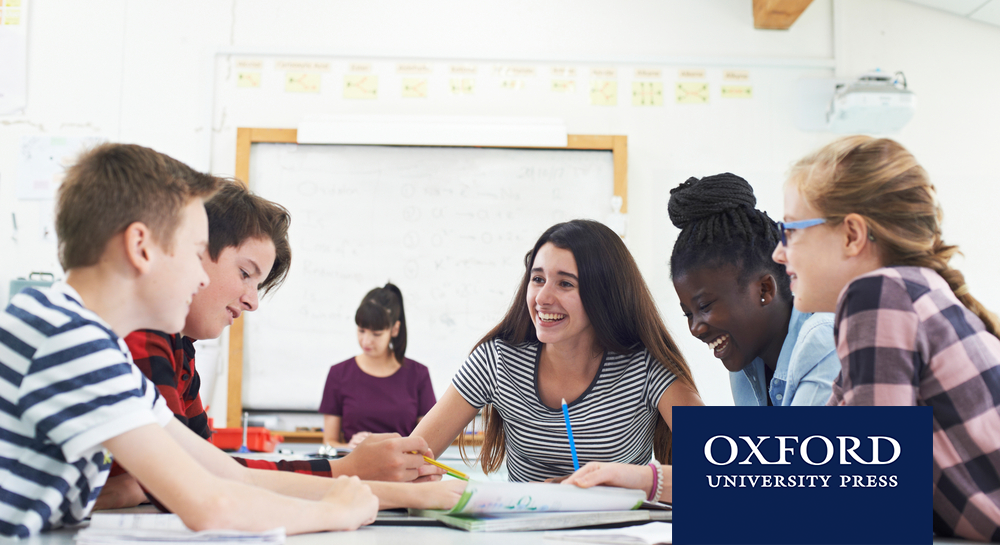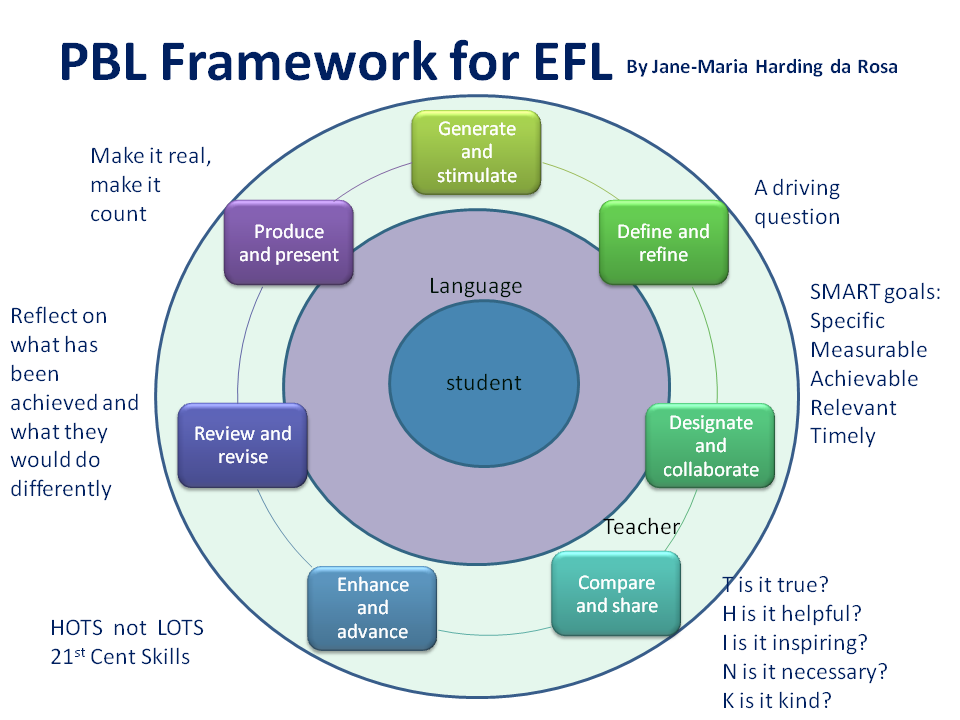 During the recent webinars I presented for OUP on Project-Based Learning, I set out a framework which could be used in ELT.
During the recent webinars I presented for OUP on Project-Based Learning, I set out a framework which could be used in ELT.
Project-Based Learning is defined by the Buck Institute for Education (2018) as a teaching method in which students gain knowledge and skills by working for an extended period of time to investigate and respond to an authentic, engaging, and complex question, problem, or challenge.
In order for this to be more accessible for English Language Teaching (ELT) we need to set out a framework and be selective to make pedagogic sense.
Generate and stimulate: This has to come from the teacher initially, especially if you are dealing with young learners or teens. It is about knowing your students and knowing what will motivate them in terms of the topics and activities you are going to ask of them. Generate interest by discussing issues that directly affect them, and this will stimulate them further. It’s the teacher’s job to build curiosity and passion in to the project, adding and stirring when necessary. As ideas are generated, areas that need further exploring should become exposed. As a group, decide which problem/area you want to explore.
Define and refine: From this you need to define a driving question – one where the answer cannot be simply ‘Googled’. Each class or group within a class should have a different driving question that is specific to their interests. You may start with defining quite a big question such as ‘What size should the trains be?‘ And refine this down to ‘How can we get as many people on the train as possible?‘. These questions should not be written in ‘educationese’ like ‘What methods could be used to maximise the capacity of the trains?’, but worded by and for the learners.
Designate and Collaborate: At this stage, the project is truly designed, and the goals are set using SMART principles (Specific, Measurable, Achievable, Relevant, Timely). The tasks and activities are designated to the learners who want them or feel they would like the opportunity to do them. There should be a strong sense of collaboration, so that not one student feels like they are doing all the work, or are isolated. At this point it is a good idea to visually display the goals which have been set, who is doing what, and timescales. This is an opportunity to value each and every member of the class.
Compare and Share: It is essential that there is a continuum of input and feedback, and this should come from peers as well as the teacher. Getting groups to compare what they are doing and sharing their ideas will only make all of the projects better. Students get a better idea of their own performance by seeing what others have done and comparing themselves in relation to each other. Giving and taking critical feedback is also an important part of development; using the THINK mnemonic (see diagram above) should set expectations and provide guidelines for peer feedback. Having a ‘growth mindset’ is about learning how to receive and use feedback productively, accepting critiques as suggestions for improvement rather criticisms of failure.
Enhance and Advance: Learners start off using the knowledge and skills that they have, but then develop these further through the tasks or research that they are doing. This is what makes perfect pedagogic sense, where they have created a context that interests them, which in turn has defined the language that they need to complete a task. This integrates language, as well as content and skills development. Essentially they are providing inherently important reasons for using the language. According to Patsy Lightbown, a lot of language is acquired through meaningful language usage. However, many features of language cannot be acquired, so it is our job as English Language teachers to provide them with the language they need to complete the task.
PBL allows us to adapt goals for learners at different proficiency levels, using the content the learners have created as a backdrop provides meaningful language. The focus should also be on developing Higher Order Thinking Skills (HOTS) such as reasoning, enquiry and discussion, creative thinking, self and peer evaluation, and hypothesizing. Compare these skills to Lower Order Thinking Skills (LOTS) such as remembering information, ordering information, defining objects and checking understanding. Other skills that need to be enhanced are 21st Century skills (for more information click here). These include: Content Knowledge and 21st Century Themes, Learning and Innovation Skills, Information, Media and Technology Skills, and Life and Career Skills.
Review and Revise: Students look back at the whole project and review what they have done, being critical of their own work. Similar to the Compare and Share stage but students need to turn the THINK questioning on to their own work and evaluate and state what they like, and what they would have done differently if they were doing it again. This helps to consolidate learning and assess what learning has taken place.
Produce and present: This is the final product and it should be presented to more than just class peers. It doesn’t have to be a poster, display, or a PPT presentation – with the advancement of technology there are so many other ways to publish the work that your students have done, from infographics to using Minecraft! Some of the other suggestions that came out through the webinar include: leaflets, videos, photo stories, podcasts, school magazines, comics, e-books, school websites, blogs, Prezzi presentations, puzzles, links with QR codes, video tutorials, Padlet, and using Google Forms and documents.
The PBL Framework is presented in a circle, as more often than not, more interest and motivation is generated during the presentation stage, stimulating more areas of inquiry and leaving questions that still need exploring. Perhaps the presentation is from another group of learners which generates and stimulates conversation with your group of learners.
The framework is only complete when we add the student to the centre, making sure that they are at the heart of the project. It is their project, rather than the teacher’s, and that needs to reflect the needs and interests of the learners.
As teachers, we need to coordinate and manage the whole process at every stage. It’s not about giving it to the learner and walking away until a final product is handed in. It’s a lot more work for us! We have to manage and micro-manage each section, stage, and learner to make sure they are all benefitting from PBL.
Lastly and most importantly, we shouldn’t lose sight of the fact that we are language teachers and we need to provide language input, so at each stage of the framework, there should be time allocated to language input. We need to provide the learners with the language they need in order to carry out the tasks, do the research, present their findings. That means a lot of different structures will be needed – we can’t expect them to know it all already. There are a lot of opportunities to develop the different skills (Reading, Listening, Speaking and Writing) while on the PBL path. These all need to feature somewhere in your lesson plans and making sure that each learner is not neglecting development of any of the skills.
Qs: Can PBL be used in the language class for adults? Is it difficult for primary students? Does PBL make sense in evening schools as well where you meet 1 1/2 hour each week for 12 times?
A: There were a lot of questions on whether PBL is suitable for different ages and levels and teaching situations. The PBL framework could, and should, be used as that – a ‘framework’ – where you adapt the content and language according to your learners, their age, stage of development, interests, language competency and number of hours you have available. There is no time scale because you can adapt it to suit the time you have available, choosing which sections of the framework to focus on if you need to.
Qs: I’ve often had students who can produce understandable but incorrect language. How much correction is really meaningful for projects? Often we need really disciplined students to complete tasks in English. How can you make them speak only English? You mentioned having language input between each stage; would this be topic related or functional language for completing the projects (collaborative phrases etc)?
A: A lot of comments came up about language and how your students didn’t have enough language to do PBL. This is where you need to identify what language they will need to do a specific task, not just the content language but functional language too, and provide some input on that, like you would in a normal language lesson. At each stage of the framework they will need different functional language, as well as different content language. Remember the ‘Enhance and Advance’ stage/element is to start with what they know and can build upon, both in terms of content and language. Providing language input is a key to a successful PBL environment. When teaching in monolingual situations, you need to create a positive learning environment where the students want to speak in English (as you would in your normal lessons). I usually nominate one student in each group (a different student each time, and not necessarily the strongest) to be the ‘English Captain’, giving them the responsibility to make sure as much English is used as possible.
Q: How do you get ideas for topics? Not all students are interested in one topic, how can we manage that? What happens if several students want to tackle the same aspect of a question? Should I have to decide with my pupils what content is?
A: Karen suggested that maybe the teacher could give a choice of projects, and students vote to choose collaboratively. One of the main objectives of PBL is to encourage collaboration, and it starts with the choice of topic. To get inspiration about some of the topics to use have a look at some of the links listed below. Defining a point of inquiry is just the start, as this soon gets refined to something more specific. If there are several students who wish to explore the same area, that is fine, it will make the ‘Compare and Share’ stage more generative and it will raise the overall level of the projects considerably. Like with all language lessons you will want to set the students home learning tasks (I’ve stopped using the term ‘homework’ as I don’t want them to get the right answers just for me to mark, but because they are learning).
At the end of the session I shared that my life philosophy is based on MMM, which is a more learner-centred, child friendly view of how language is acquired used by University of Nottingham ITE team.
MMM; Meeting new language, Manipulating it and Making the language your own.
This also supports the pedagogic reasoning behind PBL, where the learners are ‘Meeting’ the topic/content/language/ driving question, ‘Manipulating’ it as they research and develop their ideas, and by doing a presentation they are ‘Making’ it their own; they are taking ownership of the topic/content and language so that it belongs to them.
So now that you have MET PBL, it is up to you to decide if you want to MANIPULATE the ideas suggested to your individual teaching situation. If you do that, then you will certainly have a feeling of OWNING PBL…having MADE it your own. And this is exactly the sensation you want to create in your lessons, so that your learners leave with a sense of owning the project, owning the content, owning the skills, and owning the language.
 Jane-Maria Harding da Rosa worked as a Director of Studies at International House Porto where she specialised in teaching younger learners. She gained her Master’s in TEYL, and now works for IH Newcastle as a senior teacher and CELTA and DELTA tutor. She also presents workshops and training sessions. She contributed significantly to the writing and re-structuring of the IH Certificate of teaching Young learners and Teenagers, which is now assessed by Cambridge Language Assessment unit.
Jane-Maria Harding da Rosa worked as a Director of Studies at International House Porto where she specialised in teaching younger learners. She gained her Master’s in TEYL, and now works for IH Newcastle as a senior teacher and CELTA and DELTA tutor. She also presents workshops and training sessions. She contributed significantly to the writing and re-structuring of the IH Certificate of teaching Young learners and Teenagers, which is now assessed by Cambridge Language Assessment unit.
References:
Brewster, Ellis and Girard. (1993). The Primary English Teacher’s Guide. Penguin.
Buck institute for Education. (2018). What is PBL? In project based learning, teachers make learning come alive for students. [online] Available at: https://www.bie.org/about/what_pbl. Accessed 10/5/18.
Lightbown, P. (2014). Focus on Content-Based Language Teaching. Oxford: OUP.
BIE PBL YouTube Video Project Based Learning: Explained
https://oxelt.gl/2Ml9mUl
What is project-based learning? 15 PBL ideas fit for your classroom
by Lucie Renard — Jun 22, 2017
https://www.bookwidgets.com/blog/2017/06/what-is-project-based-learning-15-pbl-ideas-fit-for-your-classroom
25 Creative Ways to Incorporate More Project Based Learning in the Classroom
By Terri Eichholz April 18, 2016
https://www.fusionyearbooks.com/blog/project-based-learning/
Buck institute for Education. (2018). What is PBL? In project based learning, teachers make learning come alive for students. [online] Available at: https://www.bie.org/about/what_pbl.
Accessed 10/5/18
Other interesting YouTube videos and Blogs you may find useful:
How to Design Project-Based Learning Activities EUN Academy: https://youtu.be/_3yAODXnAsg
https://hqpbl.org/wp-content/uploads/2018/03/FrameworkforHQPBL.pdf
MMM : How many TLAs do we really need? Is there room for one more?
By Jane-Maria Harding da Rosa
https://jmhdr.wordpress.com/
There are SO MANY resources and inspiration on Pinterest which gives you links to blogs and websites.


Jane-Maria, what a great read. I’ve been using PBL for some time now and I simply love. I’ve actually written a blog post about it with my dear friend Stephan Hughes. I’d love your opinion if you could spare the time to read it about our experience:
https://wp.me/p8tO8c-Ix
This is an amazingly meaningful thoughtful understandable thorough and step by step explanation of PBL framework. Sounds both challenging and convincing to an EFL teacher but seems worth the effort. I loved every word of the article. Thank you for this wonderful piece of academic writing.
Great article! You’ve really described what PBL is and should be in a nutshell and very effectively. As a teacher trainer teaching PBL strategies and methods to teachers from all around Europe, I will be sure to share this with them. Keep up the great work!!
Dear Jane. Thank you for your article and for sharing your experience.
I am currently writing a piece on how PBL can be used to enhance learners’ 21st century skills and I was really interested in knowing what source you used to build your framework. I found many PBL procedures and step-by-step guides, but yours seemed the most complete so far. If I were to use this same frame in my article, should I cite your as my reference? Or you got it elsewhere? Thank you in advance.
[…] https://teachingenglishwithoxford.oup.com2018/06/14/promoting-project-based-learning-qa/?subscribe=success#blog_… […]
[…] *Oxford University Press ELT, 2018 […]